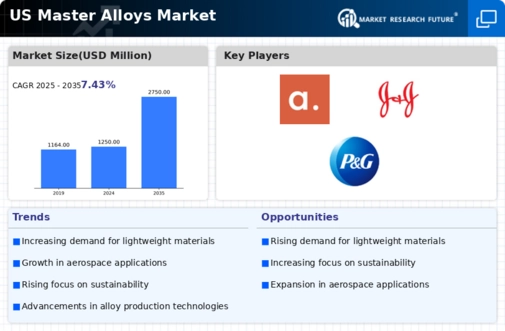The US Master Alloys Market is characterized by a competitive landscape that draws attention due to its critical role in various manufacturing sectors, including automotive, aerospace, and electronics. As industries increasingly demand specialized alloys to enhance performance and sustainability, several players have emerged to meet these needs. The competitive dynamics in this market are shaped by factors such as technological advancements, production capabilities, distribution networks, and strong customer relationships. Companies often strive to differentiate themselves through innovation, quality assurance, and tailored solutions that address specific industry challenges.
The market is also influenced by supply chain complexities, regulatory standards, and fluctuations in raw material costs, prompting companies to develop strategies that enhance their resilience and adaptability.Aleris stands out in the US Master Alloys Market due to its comprehensive portfolio and commitment to quality. The company leverages advanced manufacturing processes to produce master alloys that cater specifically to the needs of various industries, permitting customers to optimize their material properties and improve production efficiency. Aleris’s strengths include a robust research and development framework aimed at innovation and a strong emphasis on sustainability practices.
Its established presence in the market is bolstered by long-standing relationships with key clients and a reputation for delivering high-quality products that meet stringent industry standards. Aleris continues to focus on expanding its offerings while maintaining rigorous quality control, which strengthens its competitive edge within the dynamic landscape of the US Master Alloys sector.Protherm, on the other hand, has distinguished itself in the US Master Alloys Market through its wide array of specialty alloys and innovative manufacturing techniques. The company provides solutions that cater to a diverse set of applications, enhancing its relevance to various industrial players.
Protherm's key products include aluminum master alloys, which are crucial for improving the properties of aluminum-based materials. The company enjoys a strong market presence, characterized by its extensive distribution network and customer-centric approach. Protherm's strengths lie in its ability to quickly respond to market demands and provide tailored solutions, further solidified by strategic collaborations and partnerships aimed at enhancing product offerings. The company also pursues active mergers and acquisitions to expand its footprint and capabilities within the US market, emphasizing its commitment to growth and innovation in the master alloys domain.














Leave a Comment